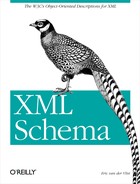Name
xs:complexType(global definition) — Global definition of a complex type that can be referenced within the same schema by other schemas.
Synopsis
<xs:complexType
abstract = xs:boolean : “false”
block = ( “#all” | list of ( “extension” | “restriction” ) )
final = ( “#all” | list of ( “extension” | “restriction” ) )
id = xs:ID
mixed = xs:boolean : “false”
name = xs:NCName
{any attributes with non-schema namespace}
>
Content: (xs:annotation?, (xs:simpleContent | xs:complexContent | (,
(xs:group | xs:all | xs:choice | xs:sequence)?,
((xs:attribute | xs:attributeGroup)*, xs:anyAttribute?
?))))
</xs:complexType>
May be included in: xs:redefine, xs:schema
Description
This component is used to create global complex types as direct
descriptions of their content model, or by derivation from simple
types or other complex types. The creation of a new complex type is
done by a compositor (xs:sequence,
xs:choice, or xs:all) that
describes the child elements, followed by a list of attributes (or
attribute groups or attribute wildcards). The derivation of a complex
type through existing simple or complex types is done by including an
xs:simpleContent (for simple contents) or an
xs:complexContent (for complex contents) element.
In both cases, when the content is not simple, the
mixed attribute defines if the content model is
mixed (i.e., allows both text and element nodes) or not.
Several controls are provided through attributes. Complex types can be declared “abstract,” their substitution can be “blocked,” and they can be “final” for derivation.
Restrictions
Constraints about keys (xs:key,
xs:unique, and xs:keyref)
cannot be defined at this level but need to be defined in the
xs:element element. This means that, while in many
cases referencing a global element definition or a global complex
type definition can be considered as equivalent to define modular
content models, complex types are no longer an option when these
constraints need to be included in the content model.
Example
<xs:complexType name="title">
<xs:simpleContent>
<xs:extension base="tokenWithLang">
<xs:attribute name="note" type="xs:token"/>
</xs:extension>
</xs:simpleContent>
</xs:complexType>Attributes
-
abstract When set to
true, this complex type cannot be used directly in the instance documents and needs to be substituted using axsi:typeattribute.-
block Controls whether a substitution (either through a
xsi:typeor substitution groups) can be performed to a complex type, which is an extension or a restriction of the current complex type. This attribute can only block such substitutions (it cannot “unblock” them), which can also be blocked in the element definition. The default value is defined by theblockDefaultattribute ofxs:schema.-
final Controls whether the complex type can be further derived by extension or restriction to create new complex types.
-
id W3C XML Schema’s element ID.
-
mixed Defines if the content model will be mixed.
-
name Name of the complex type.
